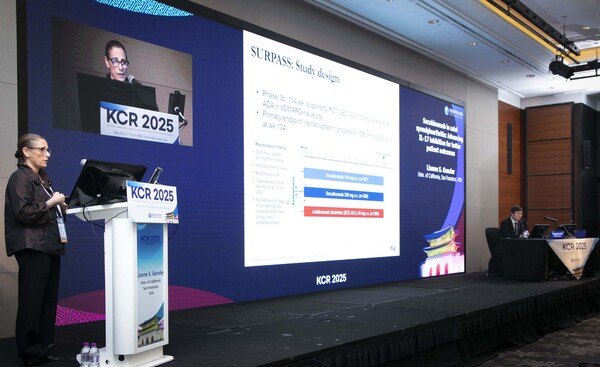Novartis Korea said it held a luncheon symposium on May 16 spotlighting the clinical value of its ankylosing spondylitis treatment, Cosentyx (ingredient: secukinumab), at the 45th Korean College of Rheumatology Spring International Conference (KCR 2025) in Seoul.

Professor Park Yong-beom from Severance Hospital served as the chair, with Dr. Lianne S. Gensler from the University of California, San Francisco (UCSF), presenting as the main speaker.
Gensler, former chair of the Spondyloarthritis Research and Treatment Network (SPARTAN) and committee member of the Assessment of SpondyloArthritis International Society-European League Against Rheumatism (ASAS-EULAR), delivered a presentation titled "Secukinumab in axial spondyloarthritis: Advancing IL-17 inhibition for better patient outcomes."
Gensler emphasized Cosentyx as a significant therapeutic option, especially for biologic-naïve patients with ankylosing spondylitis, highlighting its efficacy and safety profile.
Citing the MEASURE 2 clinical trial, she explained that Cosentyx demonstrated a significantly higher ASAS20 response rate compared to placebo at week 16 in patients without prior biologic treatment experience.
Long-term data from a five-year extension of this study showed sustained symptom improvement, underscoring its lasting clinical benefits.
In the SURPASS study, focusing on patients at higher risk of disease progression due to elevated C-reactive protein (CRP) levels and the presence of at least one syndesmophyte.
The primary endpoint -- radiographic non-progression at week 104 -- showed no significant differences among treatment groups, with Cosentyx (150mg and 300mg) and adalimumab biosimilar (40mg) all demonstrating substantial efficacy in inhibiting disease progression.
Gensler also discussed the real-world FORSYA study, noting higher one-year treatment retention rates when Cosentyx was used as the first biologic treatment, emphasizing the importance of early therapeutic intervention.
Professor Park highlighted the significance of timely diagnosis and early intervention in managing ankylosing spondylitis.
"With effective treatment options now available, patients today have better prospects for controlling symptoms and preventing joint damage," he said.
Related articles
- Korea green-lights Novartis’ Cosentyx for kids with severe psoriasis
- European guidelines recommend Cosentyx as 1st-line drug for severe hidradenitis suppurativa
- Philips, GE, Samsung lead Korea radiology meeting with AI MRI, faster breast ultrasound
- Gout, ankylosing spondylitis, and psoriatic arthritis look quite different but share more than you think
- Early biologic treatment is vital for hidradenitis suppurativa, data shows
- [Interview] ‘Early treatment changes everything for ankylosing spondylitis patients’
- Novartis Korea cleared to expand Fabhalta indication to adult C3G patients

